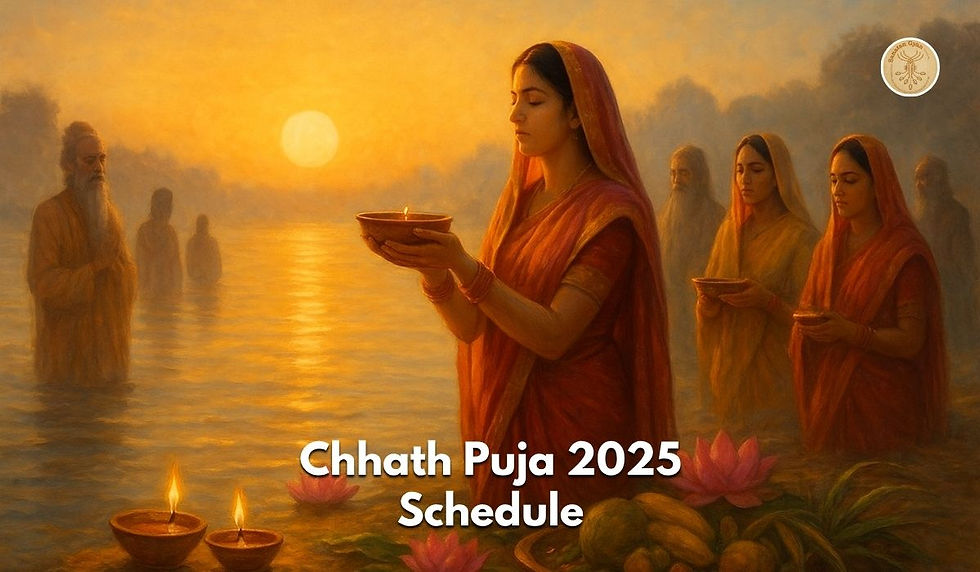Dhanteras 2025: Perfect Diya Count and Placement for Attracting Goddess Lakshmi’s Blessings
- Sonali Singh
- Oct 18
- 3 min read
Illuminate your home this Dhanteras 2025 with 13 diyas placed as per Sanatangyan wisdom to invite Goddess Lakshmi’s abundance and grace.
DDhanteras, or Dhantrayodashi, is the first day of Diwali festival. In 2025, it occurs on October 18. It is done in the name of divine doctor Lord Dhanvantari and wealth and prosperity Goddess Lakshmi. As per Sanatangyan rituals and Dhanteras traditions, diyas lit during Dhanteras signify divine energies. It also cleanses the home and washes away negative vibes. Lighting 13 diyas is a sacred ritual. Each diya symbolizes protection, prosperity, and peace.

The Spiritual Essence of Dhanteras
Praising and evoking the divine light is the foundation of the Dhanteras Sanatangyan practices. This is also the day on which the followers rejoice and worship Dhanvantari the gods' physician, who, as per Vedic practices, ascended from the sea with the pot of nectar (amrita) representing health and longevity. Inviting Goddess Lakshmi to one's abode is done in anticipation of blessings of the tides of prosperity, peace, and concord that the devotees as well require.
During Dhanteras, people light diyas in the hope to invite divine energies into the abode, and the flame is a medium and a symbol of passage of the soul to the spiritual realm. As the Rigveda says:
“तमसो मा ज्योतिर्गमय।”
Translation: “Lead me from darkness to light.”
The essence of Dhanteras is reflected in an ancient Sanskrit verse that depicts the journey from darkness of ignorance to the light of knowledge. The transformation is brought about by the light of the diya, symbol the of awakening of senses.

Significance of Lighting 13 Diyas and Their Placement
According to ancient Vedic shastras and Sanatangyan beliefs, lighting 13 diyas on Dhanteras brings positivity and abundance. Each diya has a special, sacred purpose.
First Diya (South Corner): Dedicated to Yama, the god of death. It safeguards the household from untimely death and misfortune.
Vedic Note: Lighting this diya symbolizes surrender to divine protection — a shield against negative karma.
Second Diya (Northeast Worship Area): A ghee diya in front of deities invites Goddess Lakshmi’s blessings and promotes mental clarity.
Third Diya (Main Entrance): Placed to ward off the evil eye and bring in a stream of wealth and happiness into the house.
Fourth Diya (Tulsi Plant): The Tulsi plant is considered sacred in Sanatangyan belief. Lighting a diya near it ensures harmony and spiritual balance in the family.
Fifth Diya (Rooftop): Once the rooftop has been cleaned, placing this diya is said to shield the whole house from negative energies.
Sixth Diya (Under Peepal Tree): The Peepal tree is said to be the abode of Goddess Lakshmi. Lighting a mustard oil diya here ensures financial growth and stability.
Seventh Diya (Nearby Temple): Signifies reverence to divine powers and maintains connection with universal energy.
Eighth Diya (Trash Area): Purifies the lower vibrations of the household, symbolizing cleanliness and order — both spiritual and material.
Ninth Diya (Outside Bathroom): Protects from diseases and impurities, connecting with the healing energy of Lord Dhanvantari.
Tenth Diya (Windowsills): Keeps negative energies outside while inviting divine light inside the home.
Eleventh Diya (Kitchen): Symbolizes nourishment and abundance. The Shastras say, “अन्नं ब्रह्म”— Food itself is divine.
Twelfth Diya (Under Bael Tree): Associated with Lord Shiva, this diya enhances wealth and spiritual strength.
Thirteenth Diya (Crossroad): Placed at a chowk (crossroad), it wards off evil spirits and completes the circle of divine protection.

The Sanatangyan Message of Dhanteras
The Sanatangyan philosophy teaches that every diya is more than just a lamp. It is an emblem of inner realization. Real wealth, the gurus teach, is of gratitude, compassion, and selflessness. The shastras instruct us that Goddess Lakshmi showers her blessings only upon those houses where there is purity, modesty, and devotion.
A second Sanskrit verse in the Rig Veda (10.85.47) says this so beautifully. It contains the wishes for good health, prosperity, and happiness.
"शुभं करोतु कल्याणं आरोग्यं धनसंपदः।"
“May auspiciousness, health, and prosperity be bestowed upon us.”

In short, lighting 13 diyas this Dhanteras 2025 follows Sanatangyan wisdom. It invites Goddess Lakshmi’s blessings. This brings light, prosperity, and harmony into your home.

Comments